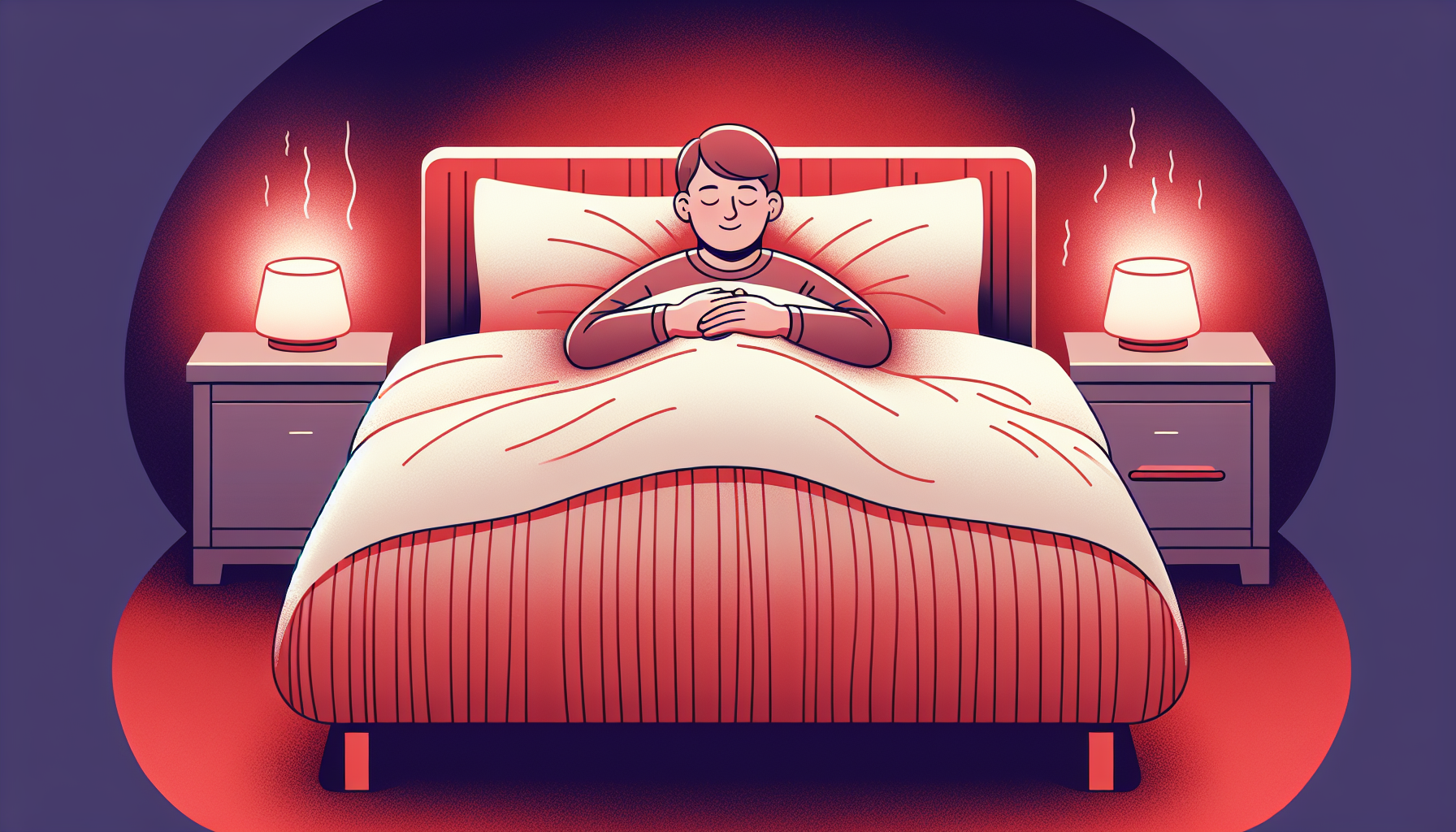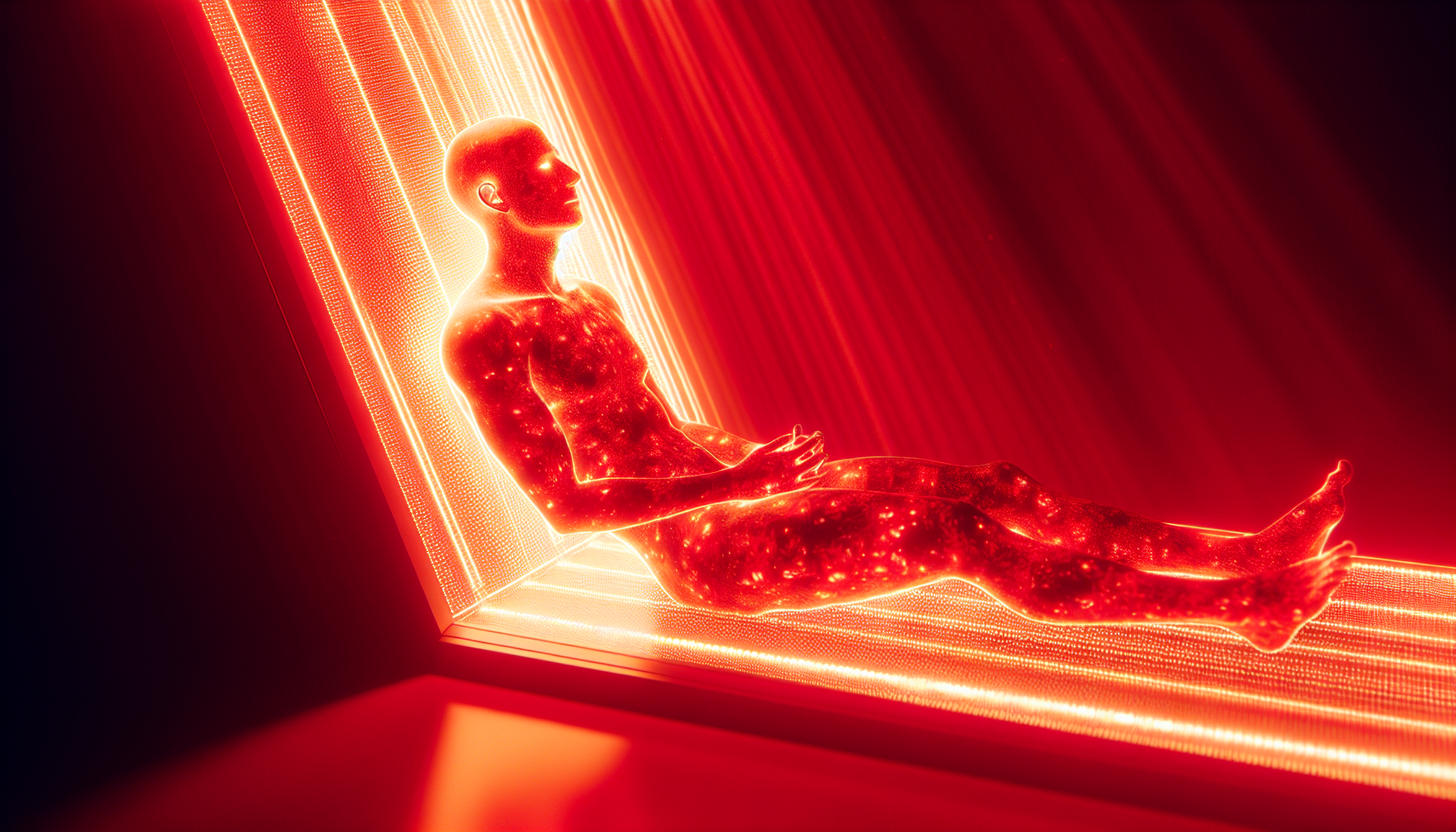Want to know how red light therapy sleep benefits work?
This guide explains how red light therapy
- boosts melatonin,
- reduces cortisol, and
- helps with sleep disorders,
supported by scientific research and usage tips.
[ > Read to the end for Thaddeus's experience with red light therapy for sleep. < ]
Key Takeaways
-
Red light therapy enhances sleep quality by stimulating melatonin production, reducing cortisol levels, and alleviating sleep disorders.
-
In addition to direct benefits for sleep, red light therapy promotes pain relief, stress reduction, and improved mood, all of which contribute to better overall sleep quality.
-
Effective use of red light therapy for sleep includes proper timing (preferably before bedtime), using high-quality therapeutic devices, and integrating other sleep-enhancing strategies.
1 Understanding Red Light Therapy
Red light therapy, a beacon in the realm of non-invasive treatments, stands out with its low-level red light wavelengths that do more than just illuminate.
These rays dive deep into the cellular world, invigorating mitochondria to
- rejuvenate skin,
- heal wounds, and
- mitigate pain.
Conceived by NASA’s ingenuity to aid in space expeditions, this therapy is lauded as a positive force in the health cosmos, free from pharmacological dependencies.
How Red Light Therapy Works
At the core of red light therapy lies photobiomodulation—a dance of light and life where cellular components tango with specific wavelengths of light.
As the mitochondria, the cell’s powerhouse, become activated, a surge in cellular energy production unfolds, akin to a blossoming of vitality.
This surge translates into enhanced healing, growth, and a reduction of the tiredness and lethargy that often accompany anxiety.
Red Light vs. Other Light Therapies
While bright and cool-colored light may jolt the body into alertness, red light therapy is the lullaby that soothes it into relaxation without jarring circadian rhythms.
Studies have shown that while bright white light can significantly disrupt sleep quality, red light’s impact is minimal, nudging the body’s internal clock by mere minutes rather than hours.
Unlike its infrared counterpart, red light’s shorter wavelengths caress only the surface of the body, promoting healing in its own gentle manner, similar to the effects of bright light.
Direct Benefits of Red Light Therapy for Sleep

Imagine a sleep so profound it rejuvenates both mind and body.
Red light therapy heralds this sleep oasis by stimulating melatonin production, easing cortisol’s grip, and soothing the turbulent waves of sleep disorders.
Enhancing Melatonin Production
As dusk falls, the body’s melatonin ushers in the night’s rest.
Red light therapy amplifies this natural symphony, inviting a deeper slumber.
With a wavelength range that harmonizes with our internal rhythms, red light is less likely to suppress this sleep-inducing hormone, ensuring our journey to the dream world is seamless.
Reducing Cortisol Levels
When cortisol, the herald of stress, ebbs away under the gentle glow of red light therapy, relaxation unfolds, paving the way for a night of restful sleep.
Alleviating Sleep Disorders
From the restless mind of insomnia to the choked breath of sleep apnea, red light therapy offers a reprieve, guiding sufferers to the sanctuary of improved sleep.
Circadian rhythm sleep disorders, such as these, can benefit from the use of red light therapy.
Indirect Benefits That Improve Sleep Quality

Beyond its direct caress on our nightly rest, red light therapy extends its healing touch through pain relief, stress alleviation, and mood elevation—each a piece of the puzzle in the quest for quality sleep.
Pain Relief and Inflammation Reduction
When pain subsides and inflammation retreats under the crimson wave of red light therapy, sleep comes more readily, unmarred by the discomfort that once stole the night.
Combating Stress and Anxiety
As red light therapy dims the oxidative stress that fuels anxiety, a serene mental state is cultivated, inviting sleep’s embrace.
This process is further enhanced by the optimal light exposure during the therapy sessions, which can help combat sleep deprivation.
Improving Mood and Seasonal Affective Disorder (SAD)
By boosting serotonin and taming the dark clouds of depression, red light therapy shines a hopeful ray on those afflicted by mood disorders and SAD, setting the stage for restful nights.
Optimal Usage of Red Light Therapy for Sleep
Harnessing the full potential of red light therapy for sleep requires more than just flicking a switch. It’s about timing, consistency, and the right equipment—elements that together weave a tapestry of tranquil nights.
Best Time to Use Red Light Therapy
The twilight hour, that serene interlude before we fall asleep, emerges as the prime time for red light therapy—a cue for the body to begin its nocturnal descent, while blocking nocturnal blue light, and aligning with our circadian rhythm in the presence of natural light.
Recommended Devices
In the realm of red light therapy, not all devices are created equal.
Renowned names like Joovv Go and MitoPRO 300 lead the pack, promising the precise wavelengths needed for sleep enhancement.
If you're in the USA, we recommend checking out GembaRed.
After researching and experimenting with red light therapies for over 20 years combined, the Primalhacker team has found GembaRed to be not only some of he most effective devices on the market, but also the most affordable and trusted.
You can read our in-depth review articles and watch our GembaRed videos here.
Combining with Other Sleep Strategies
To magnify the power of red light therapy, one might blend it with the tranquil notes of a sleep-conducive environment, the harmonious rhythm of a consistent sleep schedule, and the serene melodies of relaxation techniques.
Scientific Evidence Supporting Red Light Therapy for Sleep

The tapestry of red light therapy is woven with the threads of scientific evidence, each strand reinforcing the promise of better sleep through meticulously crafted studies and validated results.
Key Research Findings
Groundbreaking studies have cast a spotlight on red light therapy’s prowess, revealing its power to bestow restorative sleep quality and endurance, particularly among female basketball players who seek both victory and repose.
Expert Opinions
Visionaries like Dr. Michael Hamblin foresee a future where red light therapy devices become a staple in every home, their glow a testament to a revolution in home health care.
Addressing Common Concerns and Misconceptions
Despite the glow of optimism surrounding red light therapy, it’s prudent to navigate its usage with care, ensuring that the light’s intensity and wavelength harmonize with the body’s needs for safe and effective slumber.
Safety and Side Effects
While red light therapy is generally seen as a benign beacon in the health landscape, it’s not without potential pitfalls.
Proper administration is key to avoiding adverse effects like skin irritation or burns—a reminder that even the most gentle therapies require a cautious approach.
Intensity and Wavelength Considerations
The quest for optimal sleep through red light therapy is a delicate balance, with wavelength and intensity serving as the scales.
The right parameters can unlock the therapy’s full potential, ensuring that its benefits are not just perceived but profoundly felt in regulating the sleep wake cycle.
Summary
As we draw the curtains on our exploration of red light therapy, we reflect on its myriad benefits for sleep—a natural melatonin boost, a calming of the stress hormone cortisol, and a soothing touch for sleep disorders.
When wielded wisely, this gentle therapy can be a powerful ally in the quest for restful nights and vibrant mornings.
Frequently Asked Questions
Can red light therapy improve sleep for everyone?
Red light therapy can improve sleep for many people, but its effects may vary from person to person, with some finding it stimulating and others finding it relaxing. Therefore, its impact on sleep can be different for each individual.
How long should I use red light therapy before bed?
Depending on its intensity, you should use red light therapy for about 2-30 minutes before bedtime to signal to your body that it's time to wind down. This will help you prepare for sleep and improve your overall sleep quality.
What wavelength of red light is most effective for sleep?
Red light with a wavelength of 630-660 nanometers is considered most effective for sleep.
Are there any side effects to using red light therapy?
Yes, red light therapy is generally safe when used correctly, but overexposure can cause skin irritation or burns. It's important to follow recommended usage guidelines.
Can I combine red light therapy with other sleep aids?
Yes, combining red light therapy with relaxation techniques, sleep aids like melatonin supplements, and a consistent sleep routine can enhance its effectiveness. This combination can help improve your sleep quality and overall wellness.
Thaddeus's Experience with Red Light Therapy for Sleep: A Primalhacker's Perspective
For over two decades, I, Thaddeus, founder of Primalhacker, have delved into the fascinating realm of biohacking, experimenting with various techniques to optimize my health and well-being.
Sleep, being the cornerstone of physical and mental rejuvenation, has always been a focal point in my explorations.
One modality that has emerged as a game-changer in my quest for quality sleep is red light therapy.
While I initially approached it with a healthy dose of skepticism, the scientific evidence and anecdotal reports piqued my curiosity.
My foray into red light therapy began with evening sessions, strategically timed about an hour before bedtime.
The soft, red glow felt calming, a stark contrast to the harsh blue light emitted by electronic devices.
Within a few weeks, I noticed a significant improvement in my sleep quality.
Falling asleep became easier, and those occasional nights of restless tossing and diminished over time.
The most profound benefit I experienced was waking up feeling more refreshed.
The grogginess that often lingered upon waking was replaced by a newfound sense of alertness and vitality.
This newfound energy transcended the bedroom, spilling over into my daily activities and workouts.
Here are some key takeaways from my personal experience with red light therapy:
- Dosage and Timing: Consistency is key. I found that regular evening sessions, at dusk (when the sun is setting), delivered the most impactful results.
- Device Selection: Not all red light devices are created equal. After experimenting with various brands, I discovered that GembaRed, with its specific wavelengths and intensity settings, yielded the most noticeable sleep improvements for me.
- Holistic Approach: While red light therapy has been a powerful tool, I believe in a multifaceted approach to sleep optimization. I combine it with sunlight, grounding, avoiding harmful EMFs, a regular sleep schedule, a relaxing bedtime routine, and a focus on creating a sleep-conducive environment.
Red light therapy may not be a magic bullet, but for me, it has been a transformative experience.
If you're struggling with sleep issues, I encourage you to explore this modality with an open mind.
It might just be the missing piece in your journey towards restful nights and energized mornings.

2 comments
I came here after seeing you talk with Jason on Archaix. The conversation was amazing and I love your message and all the information you provide. However, I have to agree with the above comment that the site is difficult to read due to the coloring and color fading that happens as I scroll. It seems ironic. It’s easier when I’ve got my blueblockers on but still very bright and I’m guessing most people aren’t in the habit of wearing their sunglasses inside yet (I know I’m not) and might appreciate an easier on the eye palette of color.
Keep up the good work, Peace…
Couldn’t read the article because a bizarre green color blob that followed my scrolling. Why in the world would anyone make an article so difficult to read? asinine.